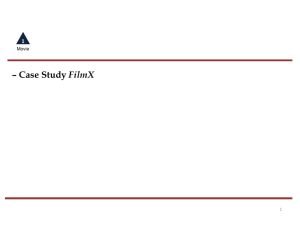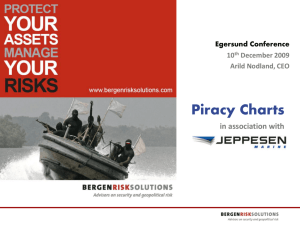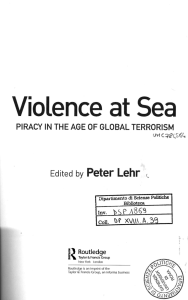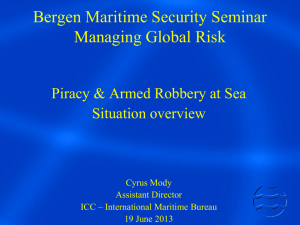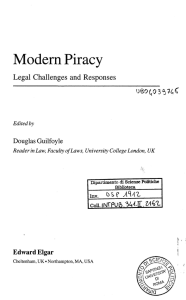Digital Piracy - Randolph College
advertisement
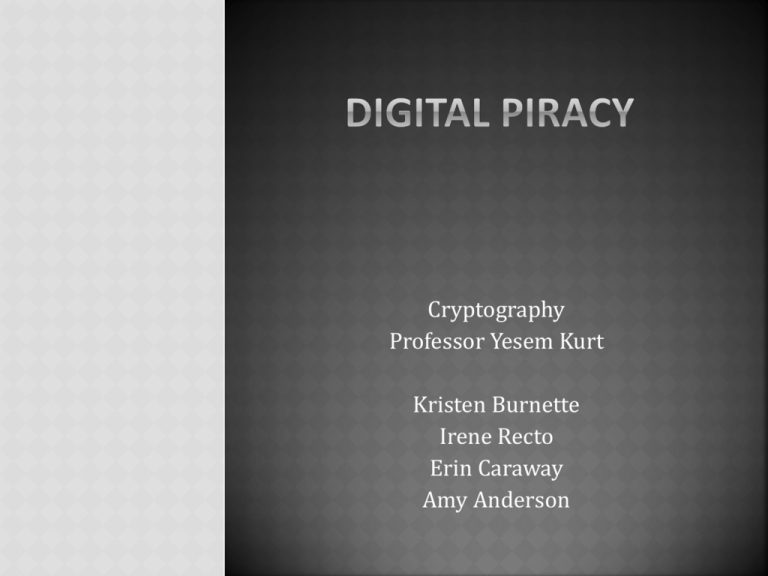
Cryptography Professor Yesem Kurt Kristen Burnette Irene Recto Erin Caraway Amy Anderson Piracy 1: an act of robbery on the high seas ; also : an act resembling such robbery 2: robbery on the high seas 3 a: the unauthorized use of another's production, invention, or conception especially in infringement of a copyright b: the illicit accessing of broadcast signals Copyright the exclusive legal right to reproduce, publish, sell, or distribute the matter and form of something (as a literary, musical, or artistic work) The United States Constitution (1787) makes a reference to copyright in Article I, section 8 it gave Congress the power "to promote the progress of science and useful arts, by securing for limited times to authors and inventors the exclusive right to their respective writings and discoveries.“ In 1990, Congress amended the copyright act, to say "prohibit commercial lending of computer software“ But there were ways around this… If a tech savvy person distributed copyrighted software without receiving any monetary benefits then they could not be prosecuted. Until 1997, with the No Electronic Theft (NET) Act, which eliminated this loophole. In 1998, the DMCAC made it a crime to circumvent anti-piracy measures built into most commercial software it also limits internet service providers from copyright infringement liability for simply transmitting information over the internet by the "safe harbor provision” DMCA Title II (OCILLA) creates a "safe harbor" for internet service providers (ISPs) from being liable for content stored or transmitted via their servers as long as they take swift steps to remove the copyrighted content when asked. This Online Copyright Infringement Liability Limitation Act also gave plaintiffs the right to subpoena user information from the ISPs to carry out individual lawsuits. There are two portions of the United States Code that deal with Domestic Copyright regulations. USC Title 17 which provides a comprehensive breakdown of every copyright guideline and section 2319 of Title 18 lists possible consequences for criminal infringement of a copyright. Under these laws, not everything conceived by the mind is eligible for copyright. When a work is classified as copyrighted, section 106 of chapter 1 gives only the proper owner of the work the rights to reproduce, prepare derivate works, distribute, publicly perform, and publicly display the creation. In addition, these exclusive rights must be granted by the owner in order for third parties to use the copyrighted material. There are four conditions of fair use Educational purposes by some special educational organizations BUT, most likely when something that is copyrighted has been duplicated or distributed without the owners consent Copyright Infringement will occur. Factor one -- "purpose and character" – if the work advances public knowledge and is transformative with little to no commerical purposes Factor two -- "nature of the copyright work" - more creative, less purely factual usages of published works have stronger protection against copyright infringement. Copying unpublished works without consent usually weakens the defendant's case for fair use. Factor three -- "amount and sustantiality of portion defendant used" the larger the portion of copyrighted work, the higher the chance the ruling will be in favor of copyright infringement and vice versa. Factor four-- "effect of defendant's use on potential market of copyrighted work" –If the work is likely to damage the originals potential market opportunities, then the court will most likely be in favor of the prosecution. (Criticism or parodies that may put the original work in a bad light are allowed even though it might damage the potential market.) Fair use Copyright infringement Advances public knowledge Fails to do so Transformative use Less transformative use Little to no commercial use Commercial use More creative, less purely factual Copying published works Less creative, more purely factual Copying unpublished works Small portions of the work copied Huge portions of the work copied Derivative work does not harm potential market Derivative work harms potential market http://www.digitalnative.org/wiki/Digital_Piracy_and_Law Prosecution can chose what they will sue for… but the US Code does outline minimum and maximum punishments for different scenerios. for statutory damages, the allowable compensation range from $200 to $150,000 per each infringed copyrighted work if the defendant has been found in violation of copyright for personal financial gain, the maximum sentence is 5 years imprisonment for the first offense. Other offenses carry 10 years imprisonment per offense. If the defendant has been found in violation of copyright for which the content had a total value more than $1,000, the maximum penalty is 3 years imprisonment for the first offense and 6 years for each additional offense in the future Hong Kong Golden Arcade – shopping center where dozens of shops sell hundreds of CD-ROM titles for only $10 They appear legitimate but they are actually counterfeits Malaysia Piracy is the cause of concern in the US because the piracy in Malaysia has caused damage of US$80 million to intellectual property owners Philippines - Availability of broadband has caused illegal Internet download that serves as a threat to legitimate sales and distribution in the country 71% software piracy rate for the past three years 2006: country’s estimated losses from software policy = $119million Philippines P2P network has allowed multiple connections , typically used for sharing files containing audio, video and other digital format eDonkey, BitTorrent, uTorrent 15,000 Indian families have regular access to Bollywood movies even when no legal production has been distributing in India Monthly rent to a website that delivers the latest Bollywood content Increasing videohosting sites makes it virtually impossible and difficult to keep track of illegal videos Isohunt.com, mininova.org Work and at home Make sure not to distribute legal software illegally (i.e. without permission) May cause legal problems in the company Careful inspections of CD-ROMS Do not download, upload or transmit software files without the copyright owners’ authorization Microsoft Certificate of Authenticity Product Activation Code PAN Network Digital Interactive Fingerprinting (DIF) for the detection, prevention and deterrence of online music and video piracy System installed in a website and interacts with media files Creates unique and virtually undetectable fingerprint when downloaded Fingerprint allows a way to trace the identity of any person who downloads a copyrighted file which will appear in an unauthorized website Bill that would encourage media companies to make more material available online More consumers would sign up for high speed “broadband” connection and digital TV sets Walt Disney and other media giants vs. technology firms Minimizing piracy by preserving consumer privacy 1) offering consumer a reward in exchange for personal information Allows firm to identify true value consumer is willing to pay for 2) tagging the digital product with a unique code that would retrieve no personal data and would prevent the same download from being played on more than one device at a time In Helsinki Finland, Rajjat Barjatya found over 15,000 Indian families who had access to Bollywood movies over the Internet. They were paying monthly rent to a website for the latest movies, which was taking large amounts of money away from producers. Ratatouille made its way online about 10 days before its release. Recent studies claim the Indian entertainment industry loses $4 billion and more than 800,000 jobs each year because of piracy. For example, when The Matrix Reloaded was released, pirates used a file-sharing computer program called BitTorrent that let thieves download films for free within three hours of its release. Legal action has closed sites that allow users to see pirated movies. Motion Picture Association of America won its battle with TorrentSpy, a peer-to-peer site that is now closed. Yet, Pirate Bay, a similar Swedenbased service, is still running. Pirate Bay creators say it is merely a platform and is neither uploading nor downloading proprietary content. It will be a while before people like Barjatya can cast a virtual safety net over their digital assets. No one expects piracy to be eliminated, but, given that a film's opening weekend often accounts for 60% to 70% of its earnings, every day's delay in the availability of pirated copies can make a big financial difference. Two members of the Digital Natives summer team, Nikki Leon and John Randall, investigated the lawsuit of Zack McCune. In April 2007, Zack McCune was sued for downloading by the Recording Industry Association of America during the time he was in college. http://blogs.law.harvard.edu/digitalnatives/20 08/07/23/the-ballad-of-zack-mccune-part-1/ As a result, McCune pleaded guilty to the charges (settled) and ended up $3,000 lighter in his payments. Issues like copyrighted music is not only limited to piracy. Believe or not, many artists have been sued for mixing copyrighted music to create new works. It’s considered as stealing music. College students are constantly blamed as the major source of digital piracy. Fortunately, this is not the case. The most incidents of piracy comes from individual households. The Recording Industry Association of America’s (RIAA) data states that off-campus consumers should be the real target of the media publicity about digital piracy. College students represent a small portion of the number of individuals cited in the RIAA's legal filings for P2P copyright violations. http://www.iimcal.ac.in/imz/images/3331Bollywood_Sign.jp g. Joshi, Priyanka. “Virtual bites: Digital piracy robs Bollywood.” Business Standard. 8 July 2008. 25 Nov. 2008. http://www.businessstandard.com/india/storypage.php?autono=328043. Leon, Nikki and John Randall. “The Battle of Zack McCune, Part 1.” Digital Natives. 23 July 2008. 25 Nov. 2008. http://blogs.law.harvard.edu/digitalnatives/2008/07/23/theballad-of-zack-mccune-part-1/. Movies – DVDRip. “Ratatouille (2007).” Show Movie. TV. 25 July 2008. 25 Nov. 2008. http://www.starstore.com/acatalog/ratatouille-solo-l.jpg. “The Battle of Zack McCune, Part 3.” John Spam. 6 Aug. 2008. 25 Nov. 2008. http://johnrandall.com/blog/2008/08/06/theballad-of-zack-mccune-part-3/. “Digital Piracy and the Law” 24 November 2007. 28 November 2008.http://www.digitalnative.org/wiki/Digital_Piracy_and_Law

